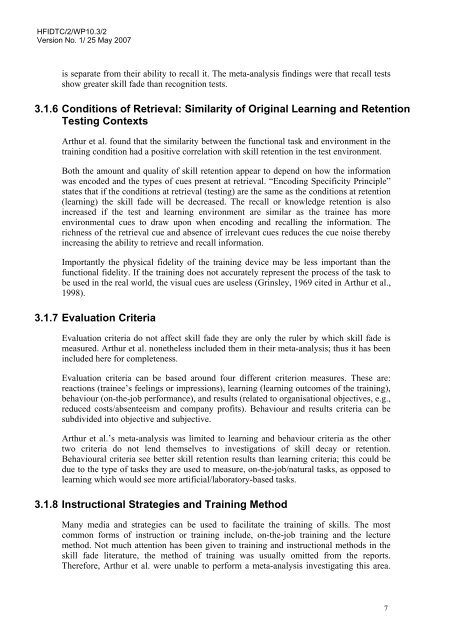Literature Review on Skill Fade - Human Factors Integration ...
Literature Review on Skill Fade - Human Factors Integration ...
Literature Review on Skill Fade - Human Factors Integration ...
You also want an ePaper? Increase the reach of your titles
YUMPU automatically turns print PDFs into web optimized ePapers that Google loves.
HFIDTC/2/WP10.3/2<br />
Versi<strong>on</strong> No. 1/ 25 May 2007<br />
is separate from their ability to recall it. The meta-analysis findings were that recall tests<br />
show greater skill fade than recogniti<strong>on</strong> tests.<br />
3.1.6 C<strong>on</strong>diti<strong>on</strong>s of Retrieval: Similarity of Original Learning and Retenti<strong>on</strong><br />
Testing C<strong>on</strong>texts<br />
Arthur et al. found that the similarity between the functi<strong>on</strong>al task and envir<strong>on</strong>ment in the<br />
training c<strong>on</strong>diti<strong>on</strong> had a positive correlati<strong>on</strong> with skill retenti<strong>on</strong> in the test envir<strong>on</strong>ment.<br />
Both the amount and quality of skill retenti<strong>on</strong> appear to depend <strong>on</strong> how the informati<strong>on</strong><br />
was encoded and the types of cues present at retrieval. “Encoding Specificity Principle”<br />
states that if the c<strong>on</strong>diti<strong>on</strong>s at retrieval (testing) are the same as the c<strong>on</strong>diti<strong>on</strong>s at retenti<strong>on</strong><br />
(learning) the skill fade will be decreased. The recall or knowledge retenti<strong>on</strong> is also<br />
increased if the test and learning envir<strong>on</strong>ment are similar as the trainee has more<br />
envir<strong>on</strong>mental cues to draw up<strong>on</strong> when encoding and recalling the informati<strong>on</strong>. The<br />
richness of the retrieval cue and absence of irrelevant cues reduces the cue noise thereby<br />
increasing the ability to retrieve and recall informati<strong>on</strong>.<br />
Importantly the physical fidelity of the training device may be less important than the<br />
functi<strong>on</strong>al fidelity. If the training does not accurately represent the process of the task to<br />
be used in the real world, the visual cues are useless (Grinsley, 1969 cited in Arthur et al.,<br />
1998).<br />
3.1.7 Evaluati<strong>on</strong> Criteria<br />
Evaluati<strong>on</strong> criteria do not affect skill fade they are <strong>on</strong>ly the ruler by which skill fade is<br />
measured. Arthur et al. n<strong>on</strong>etheless included them in their meta-analysis; thus it has been<br />
included here for completeness.<br />
Evaluati<strong>on</strong> criteria can be based around four different criteri<strong>on</strong> measures. These are:<br />
reacti<strong>on</strong>s (trainee’s feelings or impressi<strong>on</strong>s), learning (learning outcomes of the training),<br />
behaviour (<strong>on</strong>-the-job performance), and results (related to organisati<strong>on</strong>al objectives, e.g.,<br />
reduced costs/absenteeism and company profits). Behaviour and results criteria can be<br />
subdivided into objective and subjective.<br />
Arthur et al.’s meta-analysis was limited to learning and behaviour criteria as the other<br />
two criteria do not lend themselves to investigati<strong>on</strong>s of skill decay or retenti<strong>on</strong>.<br />
Behavioural criteria see better skill retenti<strong>on</strong> results than learning criteria; this could be<br />
due to the type of tasks they are used to measure, <strong>on</strong>-the-job/natural tasks, as opposed to<br />
learning which would see more artificial/laboratory-based tasks.<br />
3.1.8 Instructi<strong>on</strong>al Strategies and Training Method<br />
Many media and strategies can be used to facilitate the training of skills. The most<br />
comm<strong>on</strong> forms of instructi<strong>on</strong> or training include, <strong>on</strong>-the-job training and the lecture<br />
method. Not much attenti<strong>on</strong> has been given to training and instructi<strong>on</strong>al methods in the<br />
skill fade literature, the method of training was usually omitted from the reports.<br />
Therefore, Arthur et al. were unable to perform a meta-analysis investigating this area.<br />
7
















